On Oct. 4, 1957, the Soviet Union inaugurated the Space Age with the launch of Sputnik, the world’s first artificial satellite. Launched as a contribution to the International Geophysical Year (IGY), Sputnik weighed 184 pounds and orbited the Earth every 90 minutes, sending out a signal that amateur radio operators around the world could monitor. Sputnik’s launch caught the United States by surprise, beginning a space race between the two countries, as each superpower sought to achieve preeminence in the high frontier. The United States met the challenge by launching its own satellites and creating NASA to oversee its civilian space program. The competition led to the rapid development of space capabilities by both countries, first putting animals and then humans in space and, 12 years after Sputnik’s launch, landing the first men on the Moon.
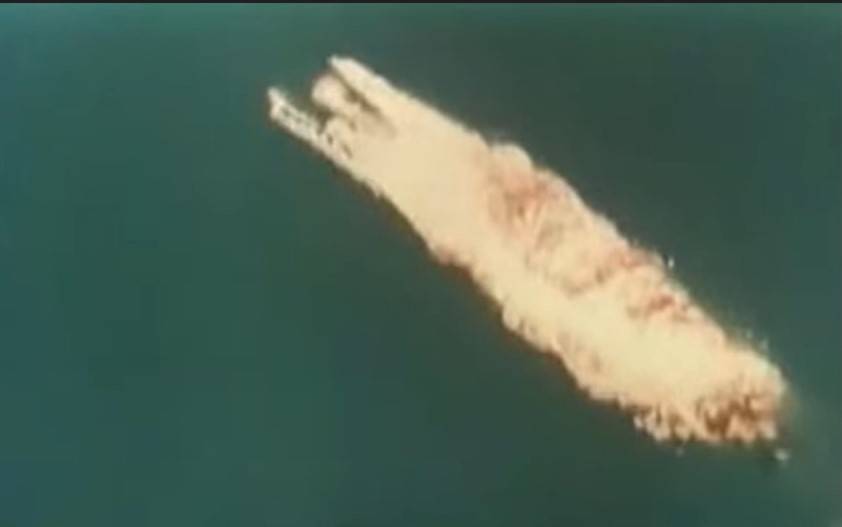
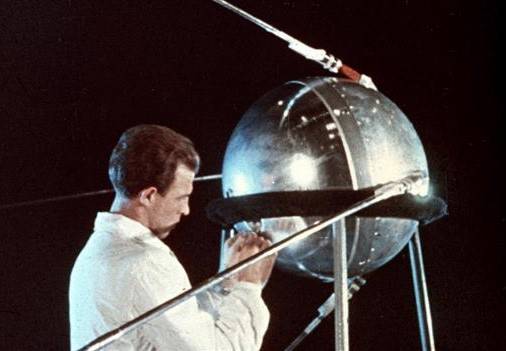
Left: An R-7 rocket breaks up soon after launch during a test flight in May 1957.
Right: A technician makes final preparations on Sputnik before its launch.
Both the United States and the Soviet Union declared their intentions to launch an artificial Earth satellite during the IGY, a multinational effort of comprehensive scientific studies of the Earth and its environment, held between July 1, 1957, and December 31, 1958. In the Soviet Union, designer Sergei P. Korolev led the effort to design and build the first artificial satellite and the rocket to launch it. He planned to use the R-7 rocket built as an intercontinental ballistic missile to place a scientific satellite into orbit before the end of 1957. When development of that complex satellite fell behind schedule, Korolev rapidly designed and built a much simpler satellite. Although the R-7 rocket suffered some catastrophic failures during its development, a final successful test flight in September 1957 cleared the way for launching the world’s first artificial satellite.
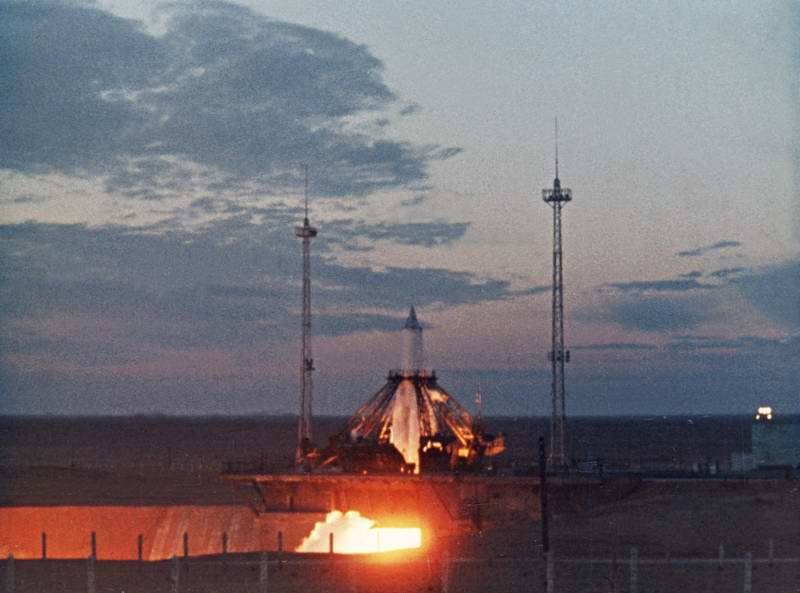
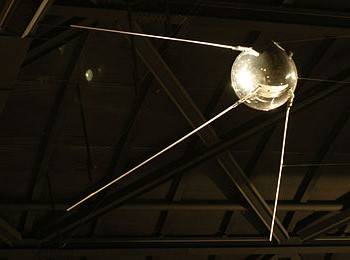
Left: The launch of Sputnik heralding the Space Age.
Right: A model of Sputnik as it appeared in orbit.
On Oct. 4, 1957, the Soviet Union announced that they had placed a satellite called Sputnik into orbit around the Earth, inaugurating the Space Age. The launch took place from a site now known as the Baikonur Cosmodrome in Soviet Kazakhstan. The rocket’s large core stage also reached orbit, and due to its reflectivity most observers saw it rather that the much smaller Sputnik satellite. Sputnik itself carried no scientific instruments, only a transmitter that sent out a “beep-beep” signal that observers around the world could monitor. Sputnik’s batteries ran out on Oct. 26, and it reentered the Earth’s atmosphere on Jan. 4, 1958. Reactions in the United States to Sputnik’s launch included shock and amazement, and led to Congressional hearings ultimately leading to the creation of NASA in 1958.
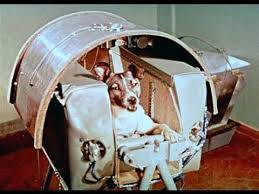
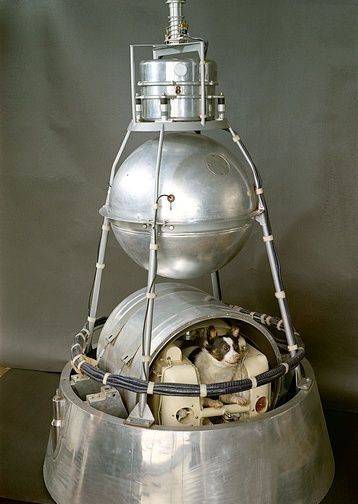
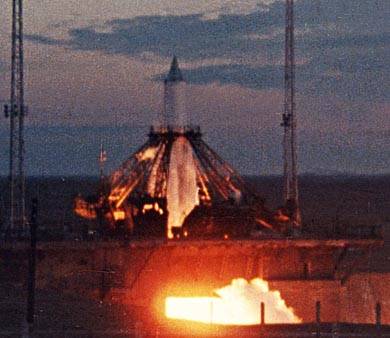
Left: The dog Laika during preflight preparations for Sputnik 2. Middle: A model of Sputnik 2.
Right: Liftoff of Sputnik 2, carrying the first live animal into orbit.
Leveraging off the success of the first satellite, the Soviet Union had another surprise. On Nov. 3, 1957, less than a month after Sputnik’s launch, another R-7 rocket lifted off from Baikonur, this time carrying a dog named Laika, the first animal to orbit the Earth. The life support equipment that Laika required made Sputnik 2 much heavier than its predecessor, 1,121 pounds versus 184 pounds. Due to the lack of adequate development time, engineers had not developed a system to recover Laika, or even designed the environmental control system to support a lengthy mission. Laika possibly survived only for a few hours after reaching orbit. On Nov. 10, the satellite’s batteries expired, and receipt of data from the science experiments also ceased. Sputnik 2 burned up on reentry on April 14, 1958. Nearly three years elapsed before the Soviet Union orbited animals again, this time returning the entire “crew” safely to Earth, in the first steps to prepare for a human spaceflight.
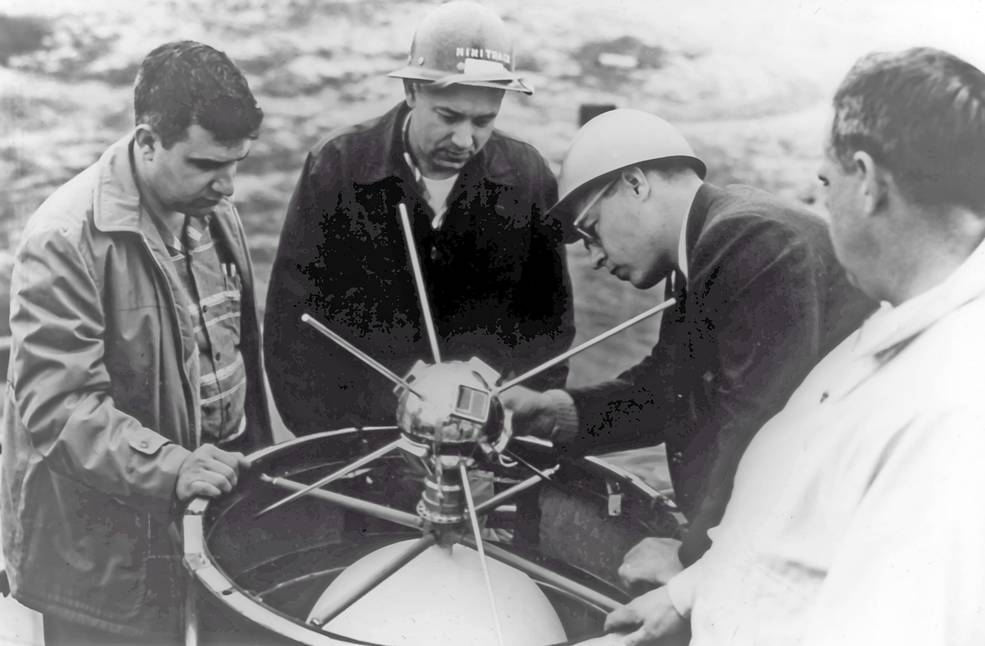
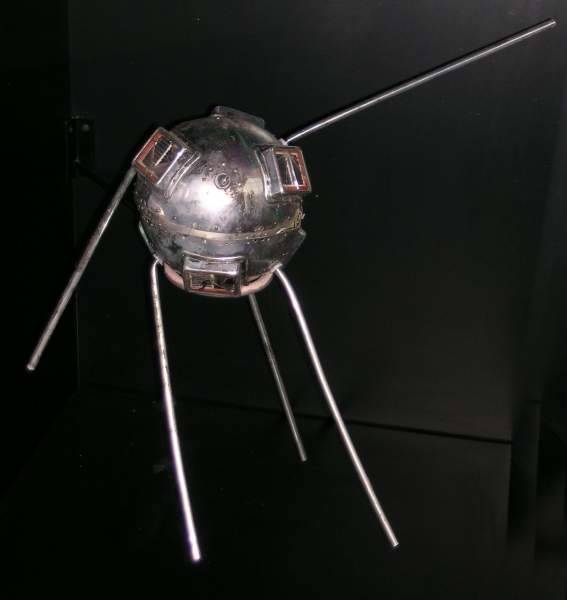
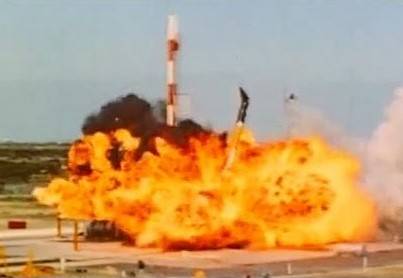
Left: Engineers place the Vanguard TV3 satellite atop its rocket. Middle: A model of the
Vanguard TV3 satellite. Right: The explosion seconds after liftoff of the
rocket carrying the Vanguard TV3 satellite.
The United States had two separate efforts to place a satellite into orbit, and following the two Sputnik launches, accelerated both programs. The first, led by the National Academy of Sciences, used the Vanguard, a three-stage rocket developed by the Naval Research Laboratory to place a tiny 6-inch, 3-pound satellite into orbit. On Dec. 6, 1957, at Cape Canaveral in Florida, the Vanguard Test Vehicle 3 (TV3) rose about 4 feet into the air, but the rocket’s main engine lost thrust and it fell back onto the pad, exploding in a huge fireball. The force of the explosion threw the Vanguard satellite free. Although ground crews recovered it, it sustained too much damaged to be repaired for another launch attempt.
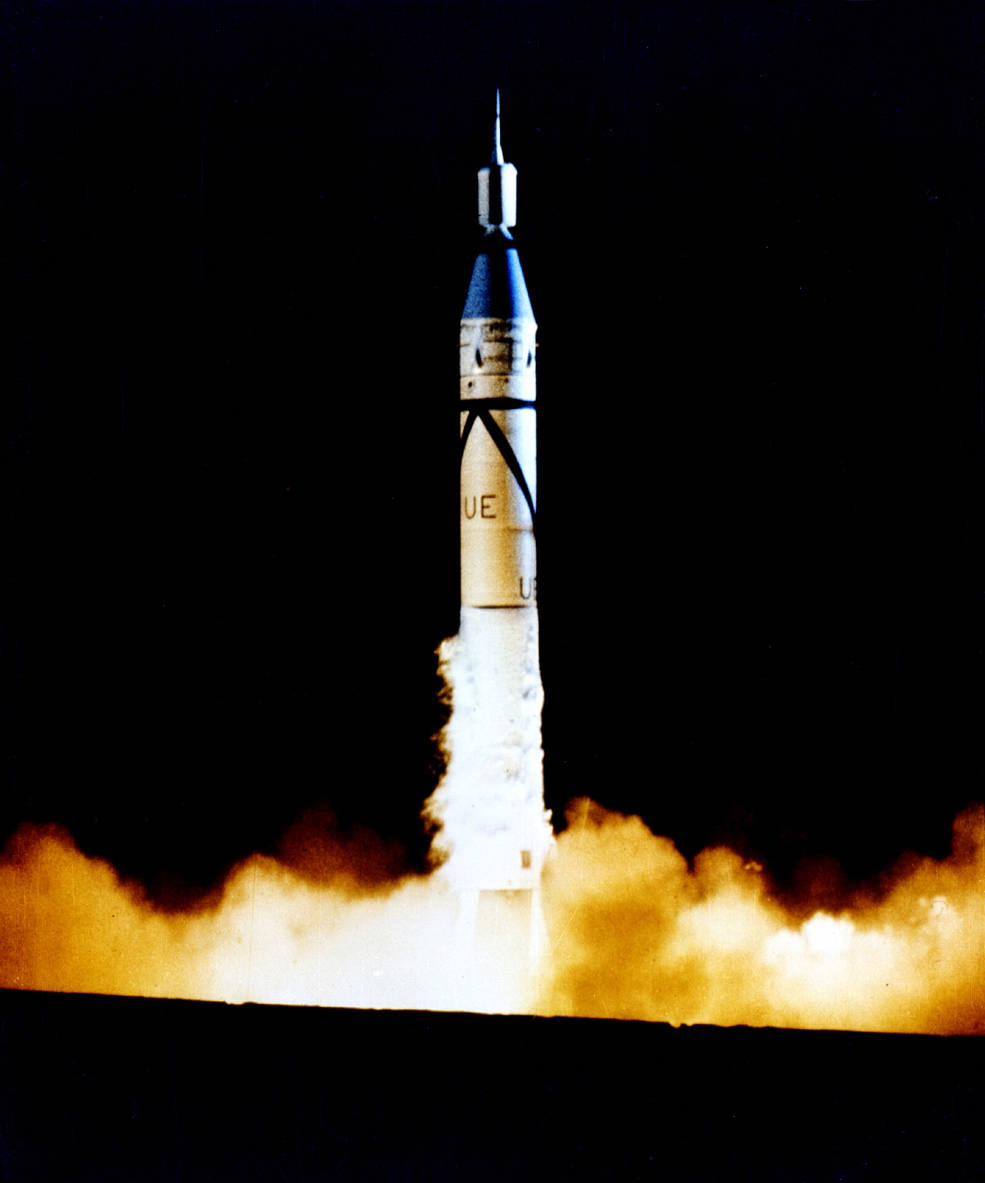
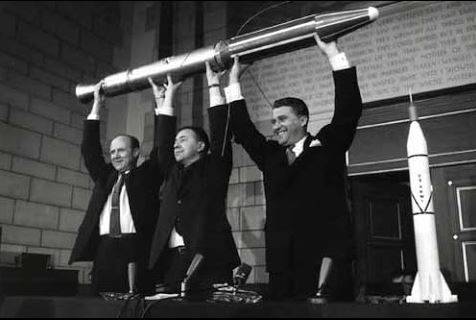
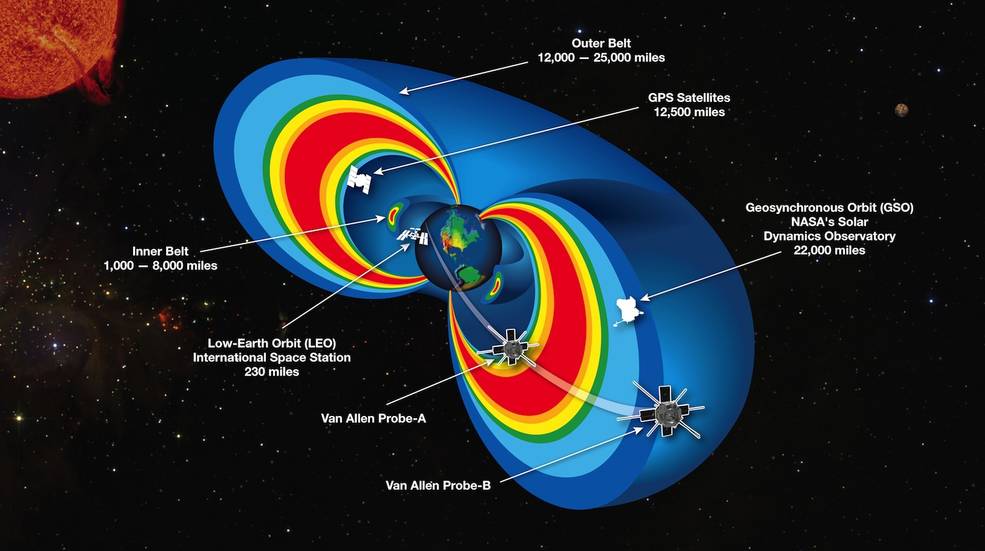
Left: Launch of Explorer 1, America’s first satellite. Middle: William H. Pickering, James
A. VanAllen, and Wernher von Braun holding a model of Explorer 1 during the post launch
press conference. Right: A schematic diagram of the VanAllen radiation
belts, discovered by Explorer 1.
The second American effort to launch a satellite involved the U.S. Army Ballistic Missile Agency (ABMA) in Huntsville, Alabama, and the Jet Propulsion Laboratory (JPL) in Pasadena, California. In 84 days, under the leadership of Wernher von Braun, the ABMA added a fourth stage to a Jupiter-C rocket to create the Juno rocket that could carry a satellite into orbit, while the JPL team under William H. Pickering developed the satellite called Explorer 1, with James A. Van Allen of the University of Iowa providing the science instruments. Explorer 1 successfully launched from Cape Canaveral on Jan. 31, 1958. A team of women mathematicians at JPL computed Explorer’s trajectory and confirmed that it indeed had reached orbit. Explorer 1 weighed 30 pounds, including 18 pounds of scientific instruments consisting of a cosmic-ray detector, five temperature sensors, and two micrometeoroid detectors. The cosmic ray detector indicated a much lower cosmic ray count than expected. Van Allen postulated that energetic charged particles originating mainly in the Sun and trapped by Earth’s magnetic field had saturated the instrument, causing it to give the false readings. Many scientists consider Explorer 1’s discovery of these trapped radiation belts, subsequently named after Van Allen, as one of the outstanding scientific discoveries of the IGY. Explorer 1 continued to record and transmit data until its batteries died on May 23, 1958.
The competition between two separate groups to independently develop and orbit the first American satellite contributed to the recognition for the need of a single civilian organization to manage America’s space program. On July 16, 1958, Congress passed the National Aeronautics and Space Act of 1958. President Dwight D. Eisenhower signed it into law on July 29, establishing the National Aeronautics and Space Administration. The agency opened for business on Oct. 1, 1958.


























